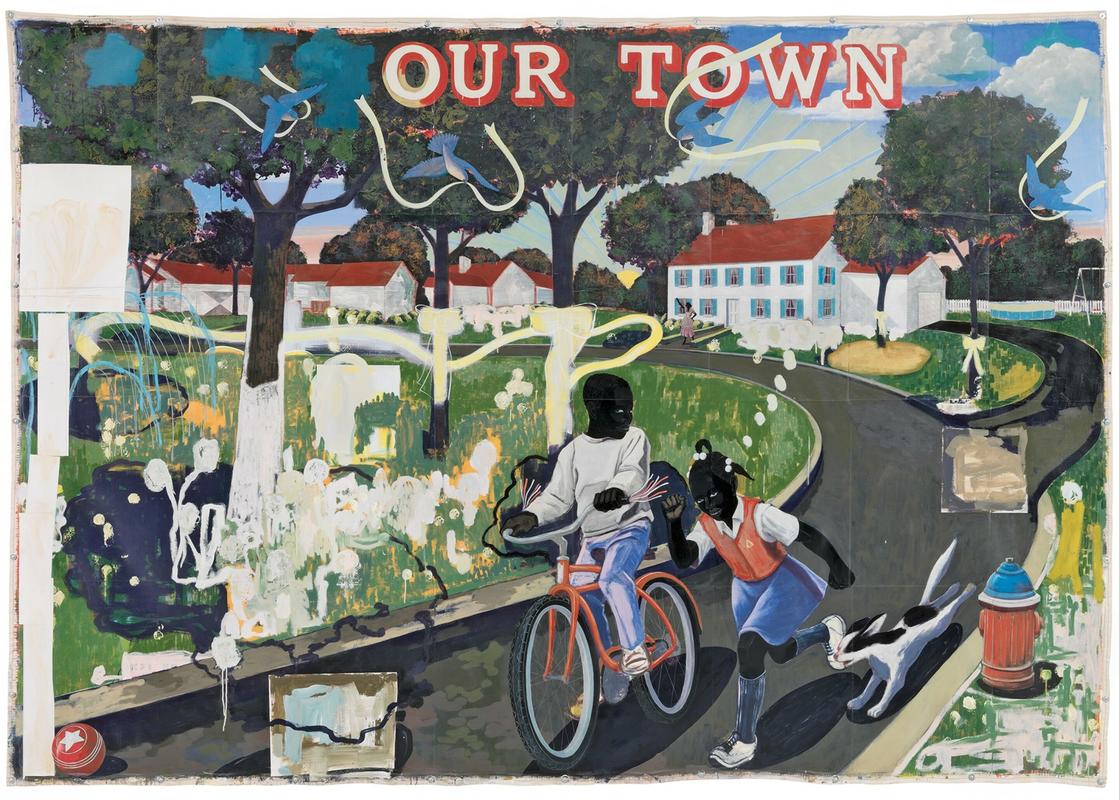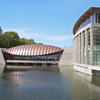More about Our Town

Contributor
Kerry James Marshall’s Our Town evokes a lot of feelings when you first look at it.
The background has the look and feel of a beat up old postcard or ad for a quaint little town in the 1950s or '60s. There are birds carrying ribbons, and sunshine reminiscent of an old Disney movie. It screams “American Dream.” Yet, there are two Black children that seem to be rushing their way out of this town, leaving the audience to come up with the reason why.
Marshall rarely paints on a traditional canvas. He instead opts to cut up pieces of paper into various non-matching shapes, and glues those to a surface, then paints over that. It gives the painting a more uneven and weathered look, leaving the viewer with the idea that this thing has been passed around and viewed by a lot of people over time, yet it endures nonetheless. This technique is important for a painting like this that attempts to tell a specific history to a wider audience. What history is that? Well, Our Town takes a swing at the commercialization of housing, and what that means for Black people.
The title of the painting is derived from a Thornton Wilder play from 1938 with the same name. At the heart of the play is a town not unlike many others, filled with everyday people stumbling through life. By telling the story of this one town, the story of the towns across the world are in turn being realized, similar as they all are. But there’s just one problem. Using a cookie cutter frame like that excludes others from the narrative, specifically anyone who isn’t white. Marshall borrowing the name of that play and centering these two Black kids rushing out of town tells a completely different story. It's a narrative that a lot of people can relate to, but not one that we are used to seeing represented, especially in art, because people like to act like things like this don’t happen. Marshall takes inspiration from other art quite frequently. It’s like his way of showing us the other side of the coin of a work of art that was created from a white perspective. He wants to show us something more inclusive of the Black American experience.
I think there are two different ways to interpret this painting. Our Town could be a depiction of what, in Marshall's view, is a typical Black neighborhood. The giant identical houses could be a nod to the housing projects where many Black families are forced to live. The willful and rugged way Marshall chose to convey the grass and the white-picket fences could be his way of saying how little care is given to these neighborhoods. The sunshine and birds could represent the perseverance of hope and happiness despite their predicament. And the kids, seemingly on their way out of town, could either be out to have a fun day in the sun, despite their harsh environment, or they could be leaving in search for something greater. Their departure is supported by a small motherly figure, just tiny enough to miss. She waves at the children as they make their way out of the frame.
The second way to look at this painting is a lot darker. This might be the quaint little 1950s town that it looks like: a white suburban utopia where the nuclear family is thriving - at least, some of them. The two kids could be riding around on a nice summer day and wind up in the wrong neighborhood, when they then have to rush their way out because of the potential danger they’re in. That might not be your first guess when glancing at this painting, but I think the interpretation has legs when you combine it with the name, our country's history of racism and violence, and the sense of urgency present within the kids' expressions.
However you interpret this Our Town, one thing is clear, these kids are in a rush to get out, either saying that their town is not enough, or that this town doesn't belong to them at all.
Sources
- Betsky, Aaron. “The Affection and Dread in Kerry James Marshall’s Depiction of Housing Projects” Architect. March 11, 2017. https://www.architectmagazine.com/design/exhibits-books-etc/the-affecti…-
- Crow, Kelly. “Vivid Visions of Epic Injustices” The Wall Street Journal. August 2nd, 2013. https://www.wsj.com/articles/SB10001424127887324809004578638223970147546
- Cudlin, Jefry. “In the Tower: Kerry James Marshall,” Reviewed”. City Paper. July 5th, 2013. https://washingtoncitypaper.com/article/208331/in-the-tower-kerry-james…











